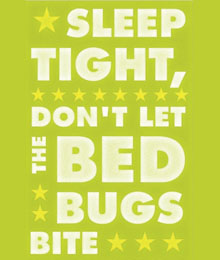Toronto’s Bedbug Crisis
October 14, 2010 by Madeline Stephenson
Filed under Health
 “It was a really stressful, stressful time. I couldn’t sleep at night,” says Caryn Solly, who was covered in itchy red bumps when bedbugs infested her apartment building in 2004. “I was sleeping with long-sleeved shirts tucked into my pants and those pants tucked into socks with the AC cranked super-high. I had to do lots of laundry and had several exterminator treatments to get rid of them.” Despite short-term relief, the bloodsucking bugs crept back into her Brooklyn, New York complex three years later.
“It was a really stressful, stressful time. I couldn’t sleep at night,” says Caryn Solly, who was covered in itchy red bumps when bedbugs infested her apartment building in 2004. “I was sleeping with long-sleeved shirts tucked into my pants and those pants tucked into socks with the AC cranked super-high. I had to do lots of laundry and had several exterminator treatments to get rid of them.” Despite short-term relief, the bloodsucking bugs crept back into her Brooklyn, New York complex three years later.
Stories like Solly’s are being broadcasted across North America, including the GTA, a region that’s seen a troubling hike in bedbug reports. On September 29, Toronto MPP Mike Colle held a summit at Queen’s Park to address an issue that’s been irking communities of every class.
With female bedbugs laying around 200 eggs in a lifetime, their staggering ability to multiply is a frightening factor for their widespread reach. Toronto Public Health has received 1,300 bedbug related phone calls from January through August 2010, compared to a significantly less – 197 calls – just five years ago. “Many people argue that they’re growing at a double-digit rate every year, and this awareness in the public is what we need so that people don’t allow them to spread,” says Mike Heimbach of Toronto-based Abell Pest Control. “Without a doubt, I can support it with research and just from the amount of business that we do, that it’s a growing concern,” he adds.
Despite common conceptions, the tiny critters don’t care about social standing or cleanliness – high-end hotels and upscale neighbourhoods have also been infested. “I think the stigma comes from people not understanding bedbugs and thinking that it only happens to people who have filthy homes or something, which just isn’t true,” says Solly. A widely held theory for the global outbreak is the discontinued use of environmentally harsh pesticides. “We’re not using DDT anymore, for good reason, but the pesticides that we have been using in homes to treat cockroaches, for example, aren’t having the same effect,” says Antonia Guidotti, entomology technician at the Royal Ontario Museum.
Health Canada is currently evaluating the risks of control products in an effort to find effective alternatives. “The department only approves pesticides that meet its standard for human health and environmental protection,” says Ashley Lemire of Health Canada, who also notes that bedbugs do not pose a major health risk and are not known to carry blood-borne diseases. Guidotti suggests inspecting mattresses, bed frames, cracks behind wallpaper, wood panelling, flooring and even picture frames and phones. She also warns travellers to inspect their hotel rooms before unpacking. Seeking professional help from an exterminator is the ideal response to a bedbug sighting. Toronto Public Health states that landlords of rental properties are responsible for incurring treatment costs.
Individuals who have been in contact with bedbugs have described their experiences as extremely traumatic and difficult to discuss. “People are really reluctant to let others know if they’ve got bedbugs because of the stigma that’s attached, but really we have to get over that,” says Guidotti. Hopefully, with conferences taking place across the continent, the facilitation of awareness and dwindling taboo will bring about a bedbug-free future. Most experts agree that communication is an essential move towards putting this pandemic – and its travelling misconceptions – to bed.








Comments
Feel free to leave a comment...
and oh, if you want a pic to show with your comment, go get a gravatar!